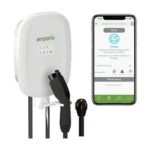Plug-in Hybrid electric vehicles (PHEVs) represent a significant step in automotive technology, blending the benefits of electric vehicles with the familiar capabilities of gasoline-powered cars. These innovative vehicles utilize a rechargeable battery to power an electric motor, complemented by a traditional internal combustion engine (ICE). This dual-powertrain system offers drivers the advantage of electric-only driving for shorter commutes, with the reassurance of a gasoline engine for longer journeys. PHEV batteries can be conveniently charged through external sources like wall outlets or dedicated charging stations, as well as through the ICE and regenerative braking systems while driving. Typically, a PHEV will operate on electric power initially, switching to gasoline once the battery is depleted, ensuring continuous mobility.
Key Components of a Plug-In Hybrid Electric Car
Understanding the components of a plug-in hybrid electric vehicle is crucial to appreciating its sophisticated operation. Here are the key parts that make up a PHEV:
Auxiliary Battery
The auxiliary battery, a low-voltage component, plays a vital role in starting the vehicle and powering accessories before the high-voltage traction battery is engaged. This ensures the vehicle’s essential systems are operational from the moment you turn the key.
Charge Port
The charge port is the gateway for electricity to enter the vehicle’s system. It allows for connection to external power sources, enabling the charging of the traction battery pack from the grid.
DC/DC Converter
This converter is essential for managing power distribution within the PHEV. It steps down the high-voltage DC power from the traction battery to a lower voltage, which is suitable for powering the car’s accessories and recharging the auxiliary battery.
Electric Generator
The electric generator is a key component in energy recovery. During braking, it harnesses kinetic energy from the rotating wheels and converts it back into electricity, which is then fed back into the traction battery, increasing efficiency.
Electric Traction Motor
The electric traction motor is responsible for propelling the vehicle. Drawing power from the traction battery pack, it drives the wheels, providing instant torque and silent operation in electric mode.
Exhaust System
Like traditional gasoline cars, PHEVs have an exhaust system to channel gases away from the engine. It includes a three-way catalyst to minimize emissions released into the environment when the ICE is in use.
Fuel Filler
The fuel filler is a standard component for gasoline vehicles, allowing for the refueling of the fuel tank with gasoline at any gas station.
Fuel Tank (Gasoline)
The gasoline fuel tank stores the fuel necessary for the internal combustion engine. This ensures extended driving range when the battery charge is depleted.
Internal Combustion Engine (Spark-Ignited)
The internal combustion engine serves as the secondary power source in a PHEV. It works in conjunction with the electric motor, taking over when the battery is low or when extra power is needed, and uses spark plugs to ignite the air-fuel mixture.
Onboard Charger
The onboard charger is crucial for managing the charging process. It converts AC electricity from the charge port into DC electricity suitable for charging the traction battery, while also monitoring battery status and communicating with charging equipment.
Power Electronics Controller
This unit acts as the brain of the electric drive system. It manages the flow of electrical energy from the traction battery, precisely controlling the electric motor’s speed and torque output for optimal performance and efficiency.
Thermal System (Cooling)
Maintaining optimal temperature is crucial for all vehicle components. The thermal system in a PHEV regulates the temperature of the engine, electric motor, power electronics, and battery, ensuring efficient and reliable operation.
Traction Battery Pack
The traction battery pack is the heart of the electric powertrain. It stores a significant amount of electrical energy to power the electric traction motor, enabling electric-only driving in a PHEV.
Transmission
The transmission in a PHEV transfers power from both the internal combustion engine and the electric motor to the wheels. It manages the delivery of power to ensure smooth and efficient driving in all modes.
By understanding these components, it becomes clear how plug-in hybrid electric vehicles offer a versatile and efficient approach to driving, bridging the gap between traditional gasoline vehicles and fully electric cars.
